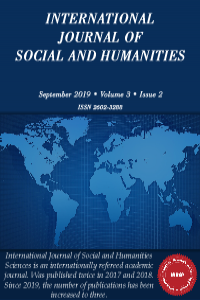Araştırma Makalesi
Yıl 2019,
Cilt: 3 Sayı: 2, 145 - 152, 30.09.2019
Öz
In the 20s of twentieth century, in Georgia, after taking power by the Soviet to-talitarian government, for the purpose of unification of the public consciousness, the Soviet government launched the mechanism of ideological dictatorship. Modernist ideological-esthetic principles accepted in Georgian literature from the European modernist trends contradicted to the soviet ideology. Socialist real-ism became the dominating discourse model. Some writers bowed to the ideo-logical dictatorship while the others ardently resisted the totalitarian government.
Grigol Robakidze, recognized ideologist of modernism in Georgia, chose to leave the country and live in Berlin, Germany, in political emigration, rather than share the Bolshevik ideas. Soviet critics declared the writer as the “enemy of the people” and his art became tabooed.
Within the scopes of this report we shall discuss Georgian emigrant writer’s landmark novel “The Snake’s Skin”. It should be noted that the novel was first published in German language (1927) and only in 1989, after rehabilitation of the writer’s name it was published in Georgian. Author of the foreword of Ger-man publication was outstanding Austrian writer, Stefan Zweig. In Germany this publication was widely discussed. Numerous reviews were published.
It should be noted that seeking of the origins, idea of returning to the father (na-tive land) is the central motif of “The Snake’s Skin” and generally, of the entire art of Georgian emigrant writer. Grigol Robakidze, regarding himself as the part of German thinking world, has dedicated his novel to Johann Wolfgang Goethe. Georgian writer offers his own interpretation of Goethe’s Urphanomen concep-tion and Friedrich Nietzsche’s idea of eternal return.
Our goal is to analyze, how Grigol Robakidze understands father’s archetype and reveal relationship of this universal image-symbol to the philosophical para-digms of the text on one hand and to the models of father’s archetype in world mythological traditions.
Anahtar Kelimeler
Kaynakça
- Bakradze, A (1999). Cardu or Grigol Robakidze's life and merit. Lomisi. Tbilisi.
- Bregadze, k. (2016). Typology of Georgian Modernism. Meridiani. Tbili-si.
- Eliade, M. (2009). Aspects of a myth. Ilia State University. Tbilisi. Tbili-si.
- Eliade, M. (2017). The myth of the eternal return. Elf. Tbilisi.
- Robakidze, G. (1928) Robakidze Gr. Das SchlangenHemd. Roman. Diederich Verlag. Leipzig.
- Robakidze, G. (1997). The Snake’s Skin. Georgian prose, volume XXX. Georgia. Tbilisi.
- Robakidze, G. (1996). Vazha Engad. For me the truth is everything. Jekservise. Tbilisi.
- Robakidze, G. (2012). The first fear and Mythos. Demon and Mythos. The book was translated from German into Georgian by Manana Kvataia. Artanuji. Tbilisi.
- Robakidze G. (2016). Letters to Stefan Zweig. The book was translated from German into Georgian by Natia Furceladze. Artanuji. Tbilisi.
Yıl 2019,
Cilt: 3 Sayı: 2, 145 - 152, 30.09.2019
Öz
Kaynakça
- Bakradze, A (1999). Cardu or Grigol Robakidze's life and merit. Lomisi. Tbilisi.
- Bregadze, k. (2016). Typology of Georgian Modernism. Meridiani. Tbili-si.
- Eliade, M. (2009). Aspects of a myth. Ilia State University. Tbilisi. Tbili-si.
- Eliade, M. (2017). The myth of the eternal return. Elf. Tbilisi.
- Robakidze, G. (1928) Robakidze Gr. Das SchlangenHemd. Roman. Diederich Verlag. Leipzig.
- Robakidze, G. (1997). The Snake’s Skin. Georgian prose, volume XXX. Georgia. Tbilisi.
- Robakidze, G. (1996). Vazha Engad. For me the truth is everything. Jekservise. Tbilisi.
- Robakidze, G. (2012). The first fear and Mythos. Demon and Mythos. The book was translated from German into Georgian by Manana Kvataia. Artanuji. Tbilisi.
- Robakidze G. (2016). Letters to Stefan Zweig. The book was translated from German into Georgian by Natia Furceladze. Artanuji. Tbilisi.
Toplam 9 adet kaynakça vardır.
Ayrıntılar
| Birincil Dil | İngilizce |
|---|---|
| Bölüm | Araştırma Makalesi |
| Yazarlar | |
| Yayımlanma Tarihi | 30 Eylül 2019 |
| Yayımlandığı Sayı | Yıl 2019 Cilt: 3 Sayı: 2 |


